 |
| The box for the
carrier. |
 |
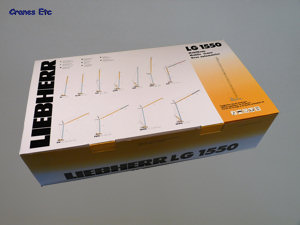 |
| The box for the
boom sections. |
 |
| The parts from
the carrier box. |
 |
| The carrier.
|
 |
| It makes a good
display model just like this. |
 |
| The chassis is
superbly detailed. |
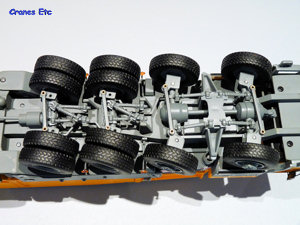 |
| Close up of the
intricate steering and suspension details. |
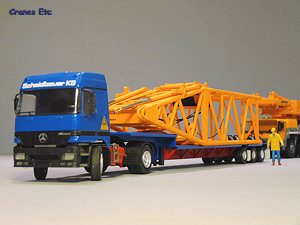 |
| The boom foot on
a Talbert
Trailer. |
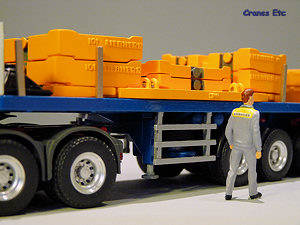 |
| The counterweight
slabs have the name and weight within the casting. |
 |
| Excellent details
between the outrigger beams. The ladder is a nice
touch. |
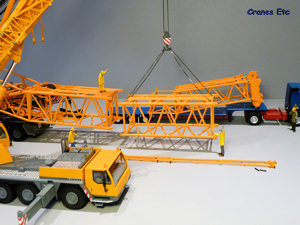 |
| A
Liebherr
LTM1200-5.1 helps build the boom. |
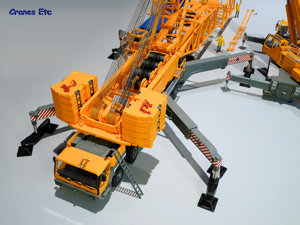 |
| The counterweight
slabs have chains to secure them. |
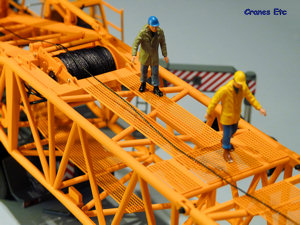 |
| Mesh walkways allow
the Cranes Etc team to act tough and walk the high steel.
|
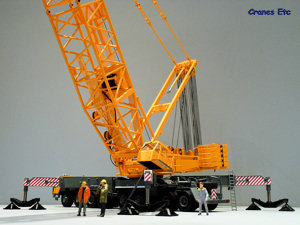 |
| Tilting cab for
the high lifts. |
 |
| Beautifully made
rooster head section. |
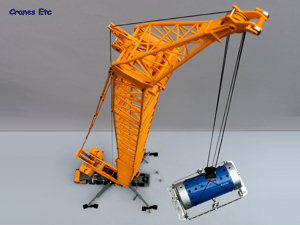 |
| Excellent straight
boom and pendants. |
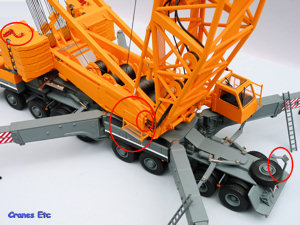 |
Small parts that
have to be fitted. On the left the red chain is pinned
in a small holder and fed through the hole in the counterweights
to secure them. In the centre the access platform
is fitted. Also the hydraulic cables from the boom
winch are fed through the side of the boom foot and plug
into the side of the body.
On the right the spare wheel winch is fitted. Two
of the four wheel chocks are shown placed in a holder at
the rear. It is also worth noting the position of
the equaliser at the back of the crane. This is located
between the inner and outer sets of ropes for the moving
mast. |
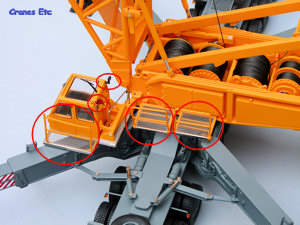 |
| From left to right:
a handrail is fitted outside the cab. Two lights are
fitted to the cab roof. Two access platforms are fitted
to the side of the body. |
|
The Liebherr LG1550 is a very versatile
lattice boom mobile crane which has a maximum capacity of
550 tonnes and can lift to heights of up to 180m.
The flexibility comes from the range of boom options available
including two types of luffing fly jib, and a derrick.
The carrier for the crane is 8-axle, and is a shared design
with that used on the LTM1800 telescopic boom crane.
One of the many applications for the crane is in the erection
of wind power systems. The crane has four of the eight
axles fitted with twin tyres meaning that 24 wheels can
carry the load of the crane enabling it to move on site
with much of the equipment and ballast loaded.
Packaging
Unusually, the model comes in two boxes. They are
surrounded by foam and packed within a larger cardboard
box. The quality of the packing is exemplary and gives
the feeling of high quality long before the model is reached.
The two picture box sleeves are in a typical Liebherr style
design-wise, but these are just covers to a high quality
plain boxes which contain the parts of the model.
When these are opened the model is contained within more
black foam rubber, and each piece is individually wrapped
in soft paper. And it gets even better. The carrier
sits in its own plastic tray and thoughtfully this is placed
in the foam rubber with red ribbon underneath, which, when
pulled, lifts the model out easily. The same technique
is used for the boom parts as well. There were no
defects or missing parts on the review model.
Two brochures are included. The first deals with the
carrier and has extracts from Liebherr technical information
and explains the boom hoist reeving. There is a list
of small parts but not all of their fitting is shown.
The second is a reprint of Liebherr technical data, complete
with loading charts, and also deals with the boom parts
and contains clear reeving diagrams. Although initially
it seems strange that the model packaging and brochures
are split in two, it does mean that at some point in the
future the boom system could be sold as a separate part
by YCC enabling owners of the YCC LTM1800 model to convert
to a lattice boom version if they wish. Similarly,
perhaps the telescopic boom of the LTM1800 could be sold
separately for LG1550 owners.
Assembly of the model is quite straightforward. The
brochures describe the main information well but leave out
some of the smaller parts. To help collectors, the
fitting of these and other parts is described in the
Assembly Guidance section below.
Depending on the configuration, a few hours should be allowed
to build the model, and as usual the slowest part is reeving
the model where, as always, patience and a methodical approach
is needed.
Detail
There is no doubt that at the time of the review this is
one of the most detailed crane models reviewed by Cranes
Etc.
The underside of the carrier is excellent with very good
transmission and suspension components detailed, and they
all in metal too. In fact the overall structure of
the chassis is modelled in a very convincing fashion and
it is almost a shame that in normal poses it cannot be seen.
The metal wheel hubs look very good, being of two types
as per the original, and mounted with excellent tyres bearing
the ĎMicheliní logo on the outside.
The driving cab has very finely made windscreen wipers and
mirrors, and the towing hitch at the front is of a realistic
size. Steps to the cab have a fine texture and the
cab is completed with excellent lights and double air horns.
The air horns have to be fitted and rest loosely on holders.
A tiny sign is on the cab side windows. Detail behind
the cab continues at an excellent level. Two tiny
grilles are present behind the driverís door, and the covers
to the engine block have superb mesh detailing. The
metal chromed exhaust is formed to have holes in the exhaust
pipes. More mesh work leads to the slewing ring and
here hydraulic cabling runs to the outrigger beams.
Alongside the body on both sides are small orange lights
which sit at the end of thin stalks. At the rear the
hydraulic details for the outrigger beams are present as
for the front pair, and there is a spare wheel with lifting
gantry, a holder for tiny wheel chocks (which are complete
with lifting handles) and the light bars have nice plastic
lenses.
The outrigger beams are beautifully made. The inner
sections have excellent hydraulic line details within the
castings and the two stage beams are metal and feel very
solid. At the end the pistons screw down to the transverse
pad beams without revealing any unsightly screw thread.
The spreader beams and pads are first class. They
are all metal and very well detailed. Better still,
they contain magnets which allow the pads to stick to the
beams and the beams to stick to the pistons which is really
an excellent design. The only minor criticism that
can be made is that the rivets connecting certain parts
are silver and would look better if they matched the painted
colour of the parts concerned.
The high quality continues into the crane body. The
cab windows have fine seals and windscreen wipers.
Inside, the controls are clearly seen, and outside there
are excellent grab rails and mesh walkways. Alongside
the body the panels have fine details within the casting
including hydraulic lines. Inside the body the winch
drums are well detailed, with some very fine diamond patterned
plate work. The pulleys used are metal and are painted
to match the crane colour so look very good indeed.
The boom gantry is raised by excellent metal three stage
cylinders which have ingenious magnet connections to the
gantry. At the gantry head there is a hydraulic lift
cylinder and top quality metal pendant connections.
On each side of the body some access platforms can be fitted
when the crane is being used. These have very good
mesh floors, although the hand rails are plastic and because
they are thin, they are delicate. These parts press
fit into holes in the body which means they are easily knocked
off if handled.
The counterweight tray has lifting points cast in and the
counterweight slabs are first rate also, with each one having
excellent lifting points and the Liebherr name and weight
clearly visible within the casting detail. Two sets
of chains and associated clips and pins are provided to
enable the counterweight slabs to be secured, and these
add to the detail. A pair of plastic ladders is also provided
with the carrier which is a nice touch for posing the crane
in use.
Moving on to the boom sections the model makerís skill continues
to be evident. The boom butt section has a wealth
of fine metal mesh walkways and there are very nice rollers
for allowing ropes to run smoothly. Two small spools
are contained within the boom section and there is hydraulic
cabling running from the winch which can be secured into
the body. The boom connections at the end are very
fine as are the small bolts used for joining the sections.
The straight boom sections are similar quality being dead
straight, and with mesh walkways and internal bracing. The
smaller LI boom sections fit nicely inside the S boom sections
so simulating accurate transport loads is possible.
Two boom head sections are provided with either 16 or 4
pulley sheaves. Once again the detail level is excellent
with metal pulleys throughout. Even the short reducer
boom section has a working roller, and eyes for fitting
a direct connection to the pendants for long boom lengths,
and the connectors are supplied with the model. Also
included is a rooster head and this difficult section is
superbly made with a folding line pulley and tiny rollers
to enable this piece to roll on the ground if needed during
erection.
The pendants are very finely made. All in metal, they
look extremely convincing and use very small plastic split
pin bolts, similar to those used to join boom sections.
On the review model one pendant line was very slightly slacker
than the other but this was barely visible.
Three hook blocks are supplied with the model and this approach
is to be particularly commended as it gives the collector
flexibility in rigging the crane. They are nominally
15 sheaves (350t), 9 sheaves (235t) and 3 sheaves (93t).
Each one is excellent in its own right and would look great
on any Liebherr crane model. They have metal sheaves
and very good hooks complete with safety catches.
Features
The steering on the carrier is good with axles 1 to 4 and
7 and 8 steering like the original. A reasonable lock
can be obtained although perhaps not as much as the real
crane can achieve.
The outrigger beams pull out laterally from the carrier
to form a star shape and can be telescoped out smoothly
to maximum extension or alternatively the model can be posed
with shortened outrigger beams like the original.
The pistons screw down smoothly to replicate a pinned bearing
connection on the transverse beams.
The crane cab is a swing away type which tucks in at the
front when in transport mode. It can also be tilted
to allow the operator comfort when the crane is lifting
at height. A working hydraulic hook is provided on
the moving mast and it is stiff enough to hold a reasonable
load.
The crane rotates smoothly, even under load.
The crane body has four winch drums and these are accessed
by using removable magnetic side panels on the body.
This excellent design feature allows the model to be operated
without having unsightly access holes in the side of the
body. Each winch is stiff enough to hold any reasonable
load, and they are can be operated by using a special tool
which has a screwdriver connection at the end so it can
be driven by a powered screwdriver which is useful for loading
the drums with the supplied thread. A fifth winch
is contained within the boom foot section and this can be
operated in the same manner.
A strong feature of the model is that it is made in the
modular system which replicates the real machine.
This means it is possible to configure the model in many
different arrangements of boom and counterweights and so
it is possible for a collector to display the model any
way they want.
Quality
This is one of the very best quality models seen by Cranes
Etc as at the date of the review. The standard of
detailing is first class and there is hardly any plastic
used. In fact it makes any of the plastic pieces that
are used feel a little out of place. The standard
of the casting is also very high.
The paintwork is very good although on the review model
there were just the slightest of differences in colour between
some parts. In part this may be explained by the different
paint used on the boom sections and the carrier, with the
carrier paint being more gloss-like, and the boom parts
having a slightly more matt texture. The quality of
the applied graphics is very good.
Price
A model such as this is not aimed at the cheap end of the
market, and it is all the better for it. Rather the
approach has been to aim for a standard of excellence and
achieve it, and with this in mind it is very good value
for money.
Overall
This model from YCC sets the highest of standards in mobile
crane models and both YCC and Liebherr can be proud of it.
Any collector wanting the very best in scale model cranes
does not need to look much further than this. In fact
given the limited production runs of these models, they
are may be a good long term investment, particularly those
in company liveries.
In some respects this model is close to a work of art and
there is no question about it, this model easily deserves
an 'Outstanding' rating.
Footnotes
The model first appeared as a prototype at the Nuremberg
Toy Fair in February 2008 and it appeared at dealers from
January 2009. A version in Wiesbauer livery became
available in January 2010 in a run of 80 models. Additional
boom sections are available as YCC part number 781.
The luffing fly jib, part number YCC 771, can be fitted
to the model, and a derrick mast, YCC 772, can also be fitted.
Assembly
Guidance
For assembly of small parts refer to the photos.
When assembling the boom sections an easier fit of pins
is achieved if a little of the paint inside the connections
is removed by gentle scraping with a small screwdriver.
Before attaching the access platforms to each side of the
model it is better to remove the paint from inside the holes
to enable a better fit.
During reeving of the boom hoist, it is necessary to get
the two separate lines of approximately the same length
so that the equaliser only has to deal with differences
caused by the way thread is spooled on the drums.
The best way to do this is to open up the moving mast fully
and reeve one half fully but leave it untied on the equaliser.
Then reeve the second half and tie both lines off at the
equaliser so they are of equal tension and the equaliser
is level.
To reeve the hooks it can be helpful to cover an amount
at the end of the thread with some glue to stiffen it up
and make it easier to push through gaps. Before starting
the reeving, spool out enough thread to be able to complete
the reeving. As the thread is passed through the safety
pin on each side of the hook block, fix it in place using
a piece of plastic putty to stop it bouncing off later.
|
|
|
|
 |
| The carrier box
is top quality with foam rubber, and ribbons to enable the
model to be lifted out. |
 |
| Two brochures,
one for the boom (on the left), one for the carrier.
|
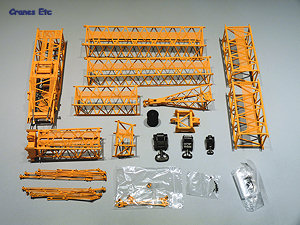 |
| The parts from
the boom box. |
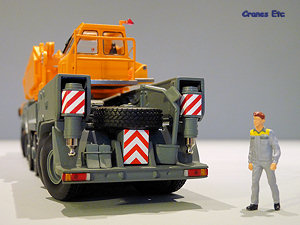 |
| Fine details at
the rear. |
 |
| The steering shown
at about the maximum lock. |
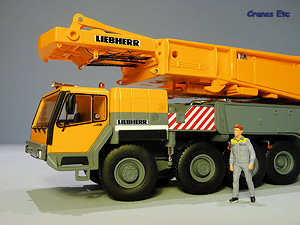 |
| The attention to
detail is shown by the very small sign on the cab window
and the grilles adjacent to the Liebherr sign above the
front wheel. The tyres have 'Michelin' on
them. |
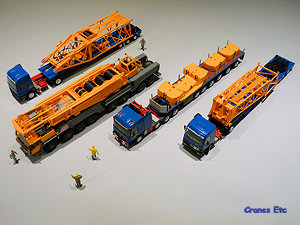 |
| With the right
transport vehicles, a good display of the crane on the road
can be made. |
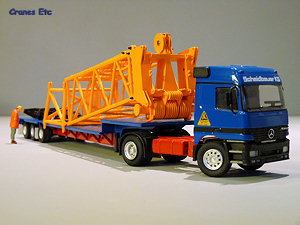 |
| Boom head and reducer
section. |
 |
| The crane being
rigged. |
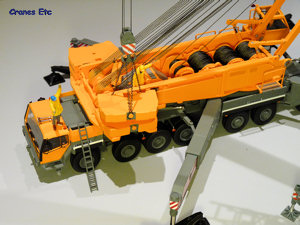 |
| Placing a counterweight
slab. |
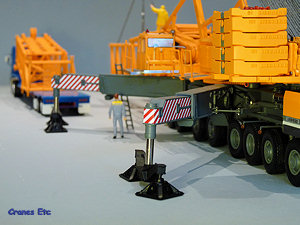 |
| Outrigger beam,
spreader bar and pads are all first rate. |
 |
| Three hooks are
supplied. |
 |
| The pendant bars
are highly detailed, and the securing bolts are split pins
of a realistic size. |
 |
| Load testing the
LG1550 with another new delivery into the Cranes Etc fleet.
|
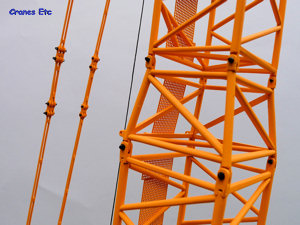 |
| The reducer section
and pendants. |
 |
| Fully rigged with
all the boom sections, the crane lifts a tank high. |
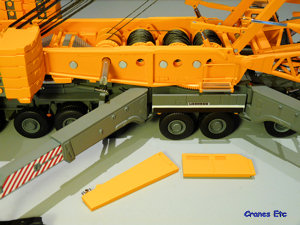 |
| The design of the
side body panels is ingenious. They are held by magnets
so to access the winch drums they are simply removed.
When the model is posed the panels are replaced and the
model is not spoiled by holes in the side of the body.
|
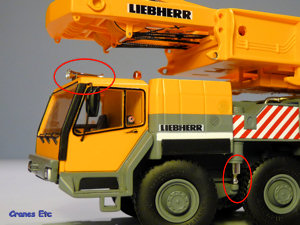 |
| Air horns are placed
on the driving cab roof and the pistons have to be screwed
into the front outriggers only. |
|

